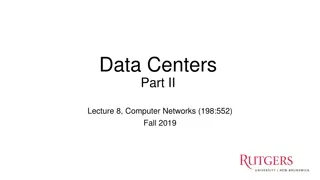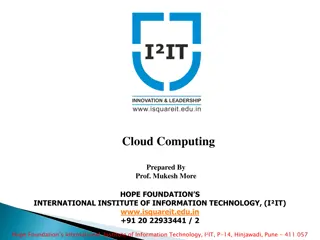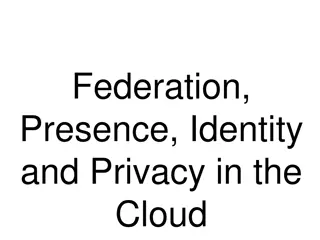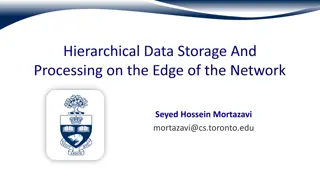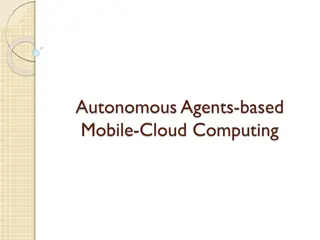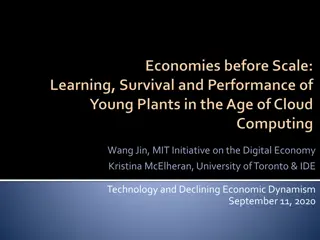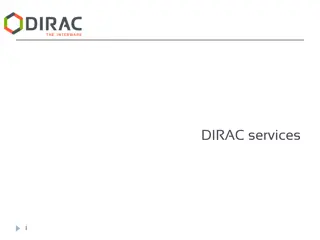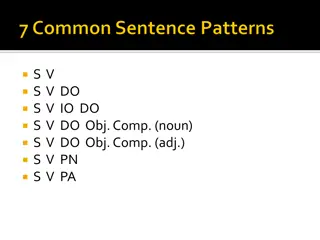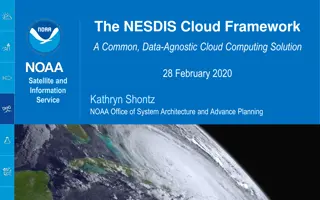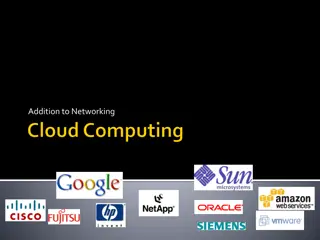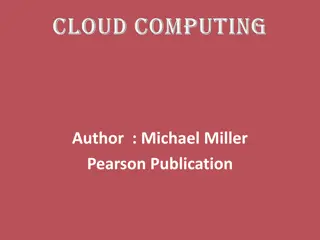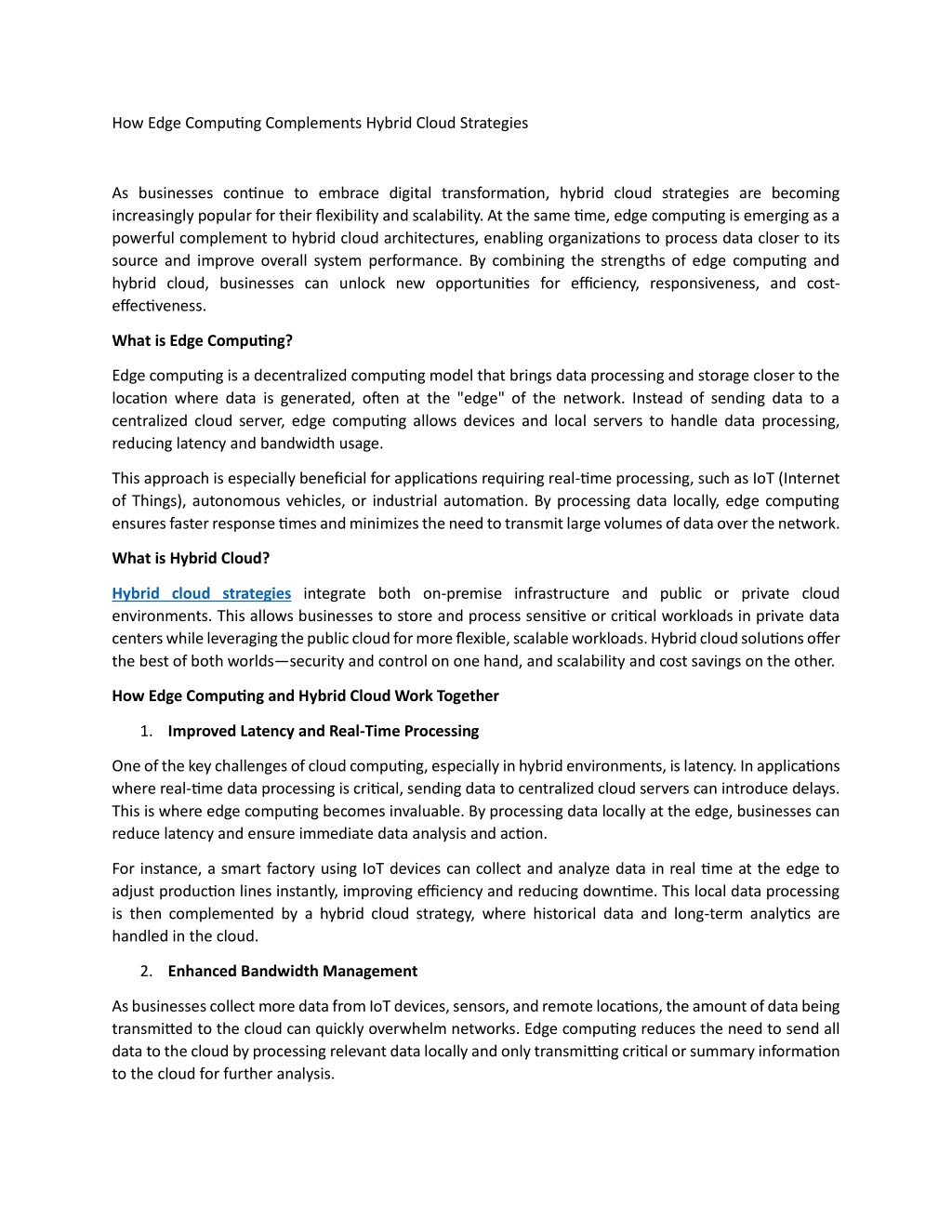
How Edge Computing Complements Hybrid Cloud Strategies
As businesses continue to embrace digital transformation, hybrid cloud strategies are becoming increasingly popular for their flexibility and scalability.
Download Presentation

Please find below an Image/Link to download the presentation.
The content on the website is provided AS IS for your information and personal use only. It may not be sold, licensed, or shared on other websites without obtaining consent from the author. Download presentation by click this link. If you encounter any issues during the download, it is possible that the publisher has removed the file from their server.
E N D
Presentation Transcript
How Edge Computing Complements Hybrid Cloud Strategies As businesses continue to embrace digital transformation, hybrid cloud strategies are becoming increasingly popular for their flexibility and scalability. At the same time, edge computing is emerging as a powerful complement to hybrid cloud architectures, enabling organizations to process data closer to its source and improve overall system performance. By combining the strengths of edge computing and hybrid cloud, businesses can unlock new opportunities for efficiency, responsiveness, and cost- effectiveness. What is Edge Computing? Edge computing is a decentralized computing model that brings data processing and storage closer to the location where data is generated, often at the "edge" of the network. Instead of sending data to a centralized cloud server, edge computing allows devices and local servers to handle data processing, reducing latency and bandwidth usage. This approach is especially beneficial for applications requiring real-time processing, such as IoT (Internet of Things), autonomous vehicles, or industrial automation. By processing data locally, edge computing ensures faster response times and minimizes the need to transmit large volumes of data over the network. What is Hybrid Cloud? Hybrid cloud strategies integrate both on-premise infrastructure and public or private cloud environments. This allows businesses to store and process sensitive or critical workloads in private data centers while leveraging the public cloud for more flexible, scalable workloads. Hybrid cloud solutions offer the best of both worlds security and control on one hand, and scalability and cost savings on the other. How Edge Computing and Hybrid Cloud Work Together 1.Improved Latency and Real-Time Processing One of the key challenges of cloud computing, especially in hybrid environments, is latency. In applications where real-time data processing is critical, sending data to centralized cloud servers can introduce delays. This is where edge computing becomes invaluable. By processing data locally at the edge, businesses can reduce latency and ensure immediate data analysis and action. For instance, a smart factory using IoT devices can collect and analyze data in real time at the edge to adjust production lines instantly, improving efficiency and reducing downtime. This local data processing is then complemented by a hybrid cloud strategy, where historical data and long-term analytics are handled in the cloud. 2.Enhanced Bandwidth Management As businesses collect more data from IoT devices, sensors, and remote locations, the amount of data being transmitted to the cloud can quickly overwhelm networks. Edge computing reduces the need to send all data to the cloud by processing relevant data locally and only transmitting critical or summary information to the cloud for further analysis.
By integrating edge computing with hybrid cloud strategies, businesses can optimize bandwidth usage, reducing costs and avoiding network congestion. This is especially useful for industries like healthcare, manufacturing, and retail, where constant data transmission can strain resources. 3.Greater Scalability and Flexibility Hybrid cloud environments already offer businesses flexibility in scaling their infrastructure. When edge computing is introduced, scalability reaches a new level. By distributing data processing across multiple edge devices and integrating them with cloud resources, businesses can scale operations efficiently. For example, a retail chain can use edge devices in each store to process customer transactions and analyze sales data locally. The summary of this data can be sent to the cloud for company-wide analysis. During high-demand periods, such as the holiday season, the hybrid cloud can easily scale to accommodate the increased data volume, while edge devices continue to manage real-time processing. 4.Improved Security and Data Compliance With growing concerns over data privacy and security, businesses are cautious about where and how they store and process data. Hybrid cloud solutions allow sensitive data to remain within a private cloud or on- premise infrastructure while leveraging the public cloud for non-sensitive workloads. Edge computing adds an extra layer of security by processing data locally, reducing the risk of exposure during transmission. This approach is particularly important for industries like healthcare, finance, and government, where strict compliance and data residency laws must be followed. By keeping sensitive data processing at the edge and storing it securely in private clouds, businesses can better meet regulatory requirements. Conclusion Edge computing and hybrid cloud strategies are a powerful combination that offers businesses improved performance, scalability, and cost-efficiency. By processing data closer to its source, edge computing reduces latency and optimizes bandwidth usage, while the hybrid cloud provides the flexibility to scale and manage workloads effectively. Together, these technologies enable businesses to stay agile, secure, and responsive in an increasingly data-driven world. As industries continue to evolve, integrating edge computing with hybrid cloud will become essential for maintaining a competitive edge. Read More: https://techhorizonsolutions.blogspot.com/2024/09/how-edge-computing-complements- hybrid.html



